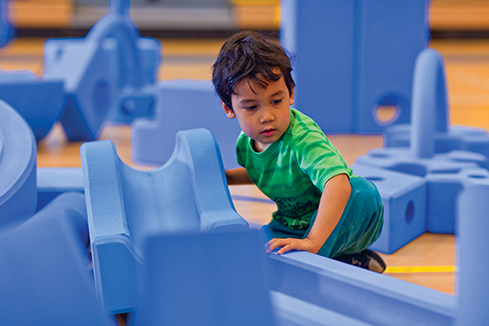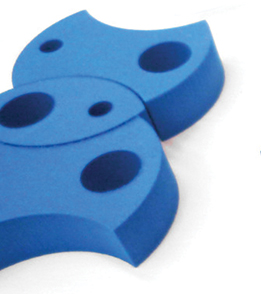 Summer 2014
Summer 2014|
“Part of its uniqueness is the scale of everything and the simplicity of the concept. It’s more of an immersive experience than just a science-engineering-building kind of activity.”
- Dennis Bateman, The Science Center's Director of Exhibit Experience and Theaters |
Big Blue
Carnegie Science Center goes oldschool, encouraging children to use blocks to build their own imaginary worlds—but on a huge, blue scale.
What was your favorite thing to build with blocks? Maybe you spent your afternoons constructing castles and forts. Maybe your evenings faded away as you tried to defy the laws of physics, stacking red on green on yellow on blue, over and over again, no matter how many times your tower tumbled. What if you could have built a playground? Or with a playground? For six months starting June 13, visitors of Carnegie Science Center will be able to build big and play hard in Blue!, a new temporary exhibit that will feature not just one but three differently-scaled versions of the Imagination Playground. Unlike traditional playgrounds with their anchored equipment, Imagination Playgrounds are made entirely of large, pool-blue, loose parts made of lightweight foam similar to that of water toys. The pieces—cubes and bricks, cogs and cylinders, curves and angles—stack like conventional blocks and connect like Tinker Toys and train tracks. In this way, the innovative design could not be more simple and time-tested. But, unlike traditional blocks, the pieces of an Imagination Playground can be as big as a preschooler. “Part of its uniqueness is the scale of everything and the simplicity of the concept,” says Dennis Bateman, the Science Center’s director of exhibit experience and theaters. “There’s a nice art feel to it, too, similar to The Warhol’s Silver Clouds installation. It’s more of an immersive experience than just a science-engineering-building kind of activity.” With Imagination Playgrounds, kids (and adults!) literally make their own open-ended fun. There’s no right or wrong way to configure them. And they’re purposefully only available in one color. This facilitates more imaginative play, without any distraction or competition that might arise from having multi-colored playthings. Play expert Ernie Dettore, who founded and heads the P.L.A.Y. Academy through the Pittsburgh Association for the Education of Young Children (PAEYC), says that children go from carrying and handling blocks to cooperative play as they enter the preschool years. “They take on roles, imaginary play, themes, adding to the structures as they go.” In this, they learn social skills and “understanding another person’s perspective—a skill that’s useful in the adult world—along with concentration and problem-solving.”
“Free play facilitates positive emotional development,” says Dettore. “With the decline in free play, there’s a decline in executive function—it’s harder to self-regulate.” So here’s what can happen in Blue!: anything. Everything. There are no rules to follow (well, almost: jumping off stacks of blocks is a no-go). The pieces are all blue to engender a blank slate. In keeping with this spirit, the entire exhibit space—walls, floor, you name it—will also be blue. And related programming will spring from this theme as well: from the blue moon to the deep blue sea. “We’ve been looking for something that has a different twist to it,” Bateman says. “Blue! will be strikingly different than anything else in the building, so we hope it attracts new audiences.” Blue! and the Imagination Playground isn’t Carnegie Museums’ first foray into incorporating unconventional playgrounds into its exhibit spaces. “Lozziwurm,” the crayon-red, yellow, and orange wiggle-shaped play structure, lives on the Museum of Art’s front lawn, inviting both children and adults to reconsider how they might interact with contemporary art before they even enter the building. Swiss sculptor Yvan Pestalozzi designed the Lozziwurm in 1972; though more than 100 of these tube-like playthings are scattered across European playgrounds, Pittsburgh’s is the first in the United States, debuting last spring as part of The Playground Project, a key element of the 2013 Carnegie International.
Bateman says that, in addition to working with varying motor-skill levels, the multi-sized blocks allow for “the idea of prototyping. If you build something with the small set, what happens when you scale it up? It’s like how architects and engineers use models.” Play expert Dettore rattles off a list of additional skills made accessible through Blue!: “You have to know shapes, stability, hypothesis, weight distribution, goal-setting. Within all that is science and math. When kids are climbing (gross m otor), there’s also balance.” He adds, “From play comes imagination. From imagination comes creativity. From creativity comes jobs. We actually invest in high-quality, early-learning experiences for children because they really are the foundation of a productive workforce.” David Rockwell, an award-winning architect, modeled Imagination Playground after the way his own kids played. The construction of the project fit into the cross-disciplinary nature of his firm, which has designed everything from the set for the Academy Awards to building space at New York’s FAO Schwarz. Imagination Playgrounds now fill parks and are on loan to schools across the country. But the back-to-basics approach to Blue! far from excludes the tech-minded, as it also features a little something from Rockwell’s LAB, which takes building-block creation into the digital realm. It’s here that visitors’ bodies and movements are translated into blue blocks on a projection screen. The best part? Your block body can shove a virtual pile of blocks so that it all tumbles down, releasing the satisfaction of what you’ve always wanted to do without having to clean up afterward. Blue! is sponsored by MedExpress.
|
Andy Warhol, Revealed · Rockhound · Picture This · Small Prints, Big Artists · Special Section: A Tribute to Our Donors · Director's Note · NewsWorthy · Face Time: Catherine Evans · About Town: A Legacy of Science · Artistic License: Home-field Advantage · The Big Picture
 |
Copyright © 2017 CARNEGIE Magazine. All rights reserved. |



